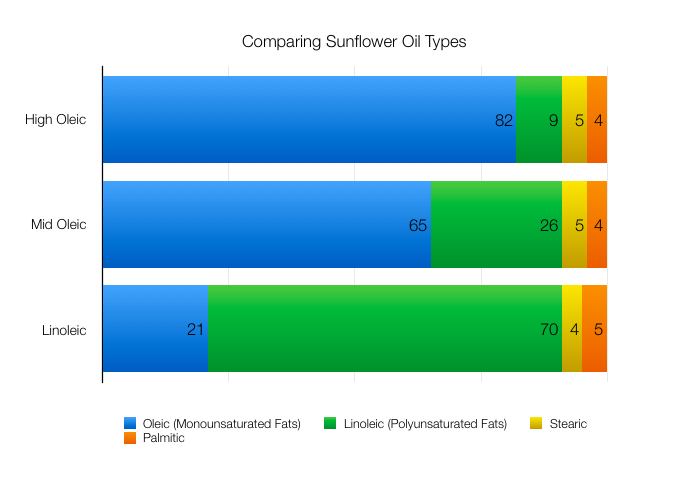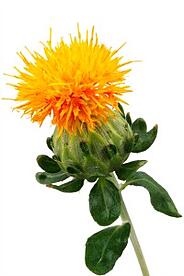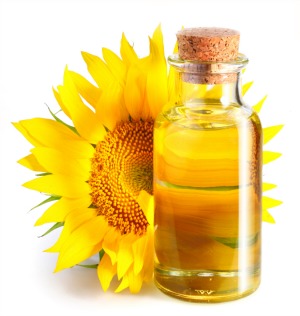Sunflower and safflower oil are very similar oils; in fact, they’re so much alike that they’re often used interchangeably.
Today we’re going to take a closer look at these two oils, how they’re similar and how they are different. Of course, if you can use both, do it! They are both good quality, naturally non-GMO oils perfect for use in the natural food industry.
If you do want to choose between the two, here’s a bit more information and background on each.
Sunflower Oil
Sunflower Oil comes in three common varieties: high oleic, mid oleic and linoleic.
These terms refer to the balance between polyunsaturated and monounsaturated fats in the oil, which are linoleic acid and oleic acid, respectively.
High oleic oils are considered the most healthy, and have the most monosaturated fat. Linoleic is comprised of more polyunsaturated fats (generally considered a less healthy fat) and mid oleic falls somewhere in between.

Linoleic Sunflower Oil
Traditional sunflower oils have fallen into two categories, one high in oleic acid and the other in linoleic acid. Linoleic acid (polyunsaturated fat) is one of the essential fatty acids in the human diet, though it’s not considered to be as healthy as oleic acid or monounsaturated fats. Linoleic sunflower oil contains nearly 70 percent polyunsaturated fat (also known as linoleic acid). Another 20 percent is in monounsaturated fat or oleic acid, and the remaining 10 to 11 percent is saturated fat.
This is often the cheapest type of sunflower oil that you’ll find on the market, otherwise referred to as “classic” sunflower oil. It is most often a solvent expelled oil.
High Oleic Sunflower Oil
High oleic sunflower oil is radically different in its makeup than linoleic sunflower oil. It consists primarily of monounsaturated oleic acids, at around 80 percent of the total. Saturated fat and polyunsaturated fat make up the balance, in equal proportions.
Bulk high oleic sunflower oil is important in the manufacture of food products, because it’s highly stable and will not go rancid in long-term storage. This makes switching from bulk linoleic to bulk high oleic sunflower oil an easy way for manufacturers to reduce trans fats, increase the make up of healthy fats in their oils, and increase shelf life.
Because it is the highest quality, it’s also the most expensive oil. This is available as an expeller pressed or solvent expelled oil.

Mid Oleic Sunflower Oil
Mid oleic sunflower oil takes a middle position between the above two traditional oils, with monounsaturated fat accounting for roughly two-thirds of the fat content, polyunsaturated fat at roughly 25 percent, and about 9 percent saturated fat.
Mid oleic oil retains high enough levels of linoleic acid (polyunsaturated fat) to remain an excellent dietary source, but the relatively high levels of oleic acid (monounsaturated fat) make it less prone to rancidity and breaking down.
This oil has been in high demand in 2017 by some of the major users, and supply is very low over the coming year. High oleic sunflower oil makes a good replacement if necessary.
Safflower Oil
The majority of the safflower oil available on the market today is high oleic safflower oil. This has similar lipid make up and oil properties to the high oleic sunflower oil, described above.
A high linoleic variety of safflower oil does exist in small volumes, but it is very rare in the food industry; it is slightly more common in body care and pharmaceuticals, but still only available in smaller amounts.
High oleic safflower oil contains monounsaturated fats, while high linoleic safflower oil contains more polyunsaturated fats. Source
Similarities Between Safflower And Sunflower
Sunflower oil and safflower oil are very similar in both make up and characteristics, and how they function in a product. This is so true that these oils are often used interchangeably in a recipe; look on the back of natural chips, and you’ll often see “high oleic expeller pressed safflower and/or sunflower oil” listed.
Both oils are similar in the following ways:
Light Color
Both sunflower and safflower oil are a light yellow color. They don’t contain very much color like an olive oil would, and are quite consistent over time since they are both refined.
Mild Flavor
Both of these oils also have a mild flavor. Since they are both refined, much of the flavor is removed in the high heat process. This means that both oils won’t impart much of a flavor into your product.
Similar Price Point
The price points of these two oils are very similar. This is because the oils are often used interchangeably (so supply and demand will depend on the other oil) and because they are produced using very similar methods.
Some years, high oleic sunflower oil will cost less, and other years high oleic safflower oil will cost less. But across the board, they are very similar.
Differences Between Safflower And Sunflower
Though these oils are very similar in some key ways, they also have their differences (although slight). Let’s review.
Different Plant
 Sunflower oil is produced from the sunflower plant — yep, this is the same plant that you place in a vase on your table and that you get sunflower seeds from for baseball season.
Sunflower oil is produced from the sunflower plant — yep, this is the same plant that you place in a vase on your table and that you get sunflower seeds from for baseball season.
Safflower oil comes from a prickly stalky plant; this plant grows in dry terrains, and has tall stalks with spiky bright flowers. Inside those bulbs below the flowers are seeds, which is what the oil is produced from.
More Varieties of Sunflower
Sunflower oil comes in three common types: high oleic, mid oleic and linoleic (sometimes called “classic” sunflower oil). While the high oleic variety is common in the natural food industry, the mid oleic and linoleic varieties are produced in much larger volumes around the world. Classic sunflower oil (or linoleic) is actually quite common in low-cost retail bottles, especially in other countries like India, Africa and in the middle east.
Price Points Of Sunflower vs Safflower Oil
Keep in mind that prices for only the high oleic versions of each of the oils are similar.
Sunflower oil also has large volumes of the cheaper linoleic variety produced, which will be much cheaper than the high oleic versions of either sun or saff.
 Higher Supply of Sunflower Oil
Higher Supply of Sunflower Oil
Sunflower oil is a much more globally developed oil. This means that there’s much more produced of it, and it’s been a popular choice for much longer. If you are looking for very very high volumes, sunflower is going to be the best option.
Comparing Supply & Production
In 2013, global production of safflower seeds was 718,161 tonnes, with Kazakhstan accounting for 24% of the total. Other significant producers were India, the United States, Mexico and Argentina. Source
In 2014, world production of sunflower oil was 14.98 million MT, per the FAS with Ukraine and Russia accounting for about half of the total. Source
Organic Varieties
Organic High Oleic Sunflower Oil and Organic High Oleic Safflower Oil are the most common organic oils, because most people that are looking for organic varieties are also looking for the healthiest type of oil.
Organic mid oleic and organic linoleic sunflower oil is also available, but they’re much less commonly available.
Other Trends & Comparisons
Safflower Oil Is Popular In Foodservice & the PNW
Safflower oil has been particularly popular in the foodservice realm (especially, I've noticed, in the Pacific NW). Part of this is because it has a high smoke and it’s great as an ingredient in prepared foods and cooking alike. Part of it is a little bit unexplained and is just a regional preference.
Sunflower Oil Is Popular In Manufacturing
Sunflower Oil has been particularly popular in manufacturing because it is available in such large volumes and at a variety of fat makeups (polyunsaturated to monounsaturated fat ratios) and price points. This makes it a very versatile oil.
For example, in 2006 potato chip giant Frito-Lay moved to sunflower oil. Many other natural snack food companies also use Sunflower Oil as a primary ingredient — even when their packaging reads as an “and/or” statement.
Food Manufacturers Are Choosing Both
Food manufacturers are often opting to leave their options open, to include both sunflower and safflower oil on their ingredient labels. This allows them to keep as open of a supply chain as possible, protecting themselves from risk of blight, crop/supply issues, and price fluctuations.
If you’re debating if this open ingredient statement is right for your product, I suggest reading Why It's Ideal To List Multiple Interchangeable Bulk Oil Ingredients.
Topics: Sunflower/Safflower Oil












